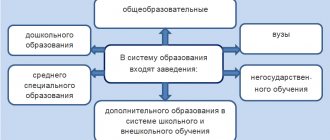What is the order of payment in a payment order?
One of the fields that the payer must fill out when drawing up a payment order is called “payment order” and has the number 21. As follows from the explanations for the procedure for filling out payment orders (Appendix 1 to the Bank of Russia regulation dated June 19, 2012 No. 383-P), in the props “Och.
payment." The number indicates the order of payment in accordance with federal law. The general sequence of writing off funds from the account is established in paragraph 2 of Article 855 of the Civil Code of the Russian Federation (note that part two of the Civil Code of the Russian Federation was put into effect by Federal Law No. 14-FZ of January 26, 1996).
According to this norm, payments are made first of all on the basis of writs of execution, which order the withholding (collection) of alimony or funds for compensation for harm to life and health.
The second stage of payments are transfers within the framework of executive documents for the transfer of wages, severance pay or royalties.
“Ordinary” wages (including debts paid voluntarily, and not under a writ of execution) are transferred from the account in third place. Also, in the third place, money will be written off based on collection orders from the Federal Tax Service, Pension Fund and Social Insurance Fund.
Calculate your salary and benefits taking into account the annual increase in the minimum wage Calculate for free
The fourth priority consists of payments under enforcement documents providing for any other penalties (debt under contracts, fines, penalties, etc.).
All other payments are transferred in fifth place.
Important
Within one queue, payment orders are executed in the order they are received by the bank.
Fill out payment slips with current BCC, income codes and other mandatory details Fill in for free
Sequence of salary payments to employees
Payments to employees may have different priorities. Let's look at it:
- If this is a salary payment under normal circumstances, code 3 is entered. It is also relevant for payments under the BiR and vacation pay.
- If the employer has a debt to the employee, payments for it receive code 2.
- If an employee works for a company on the basis of a civil law agreement, code 5 is relevant.
Why is code 5 used in the latter case? Money paid to an employee on the basis of a civil contract will not be considered salary. Therefore, these payments are not considered a priority.
Why indicate the order of payment in a payment order?
Paragraph 1 of Article 855 of the Civil Code of the Russian Federation states: if there is enough money in the account to fulfill all the requirements presented to the account, funds are written off in the order in which payments are received. A similar rule is contained in paragraph 2.10 of Regulation No. 383-P. It says that if there are sufficient funds in the payer’s bank account, orders (payment orders) are subject to execution in the sequence of their receipt by the bank.
Accordingly, establishing the order of payments is necessary, first of all, in case the account at some point does not have funds to execute all payments. Then the bank will transfer money not in calendar sequence, but taking into account the sequence indicated in field 21.
In addition, recording the order of payment in the payment order is necessary in case of arrest or blocking of the account. In such situations, the bank has the right to make payments that occupy a higher step in the queue than those for which the account was arrested (blocked). For example, a decision by tax authorities to suspend operations due to non-payment of taxes (Article of the Tax Code of the Russian Federation) will not prevent the bank from transferring alimony and wages according to executive documents.
When will current taxes be written off?
Current tax payments will go to the last, fifth place. This same level of priority includes, for example, payment for goods and services, payment of state duties, and so on. There is a chronological order inside the queue, that is, the payment that arrived earlier will go first.
Let us once again draw attention to the fact that in this queue we are not talking about tax debt under writs of execution - it is paid in third place.
What order of payment should I indicate in 2021?
When filling out field 21 of payment orders in 2021, you must adhere to the following order.
To transfer payments for taxes, fees, and contributions, you should enter 5 (letter of the Ministry of Finance dated January 20, 2014 No. 02-03-11/1603). The same figure must be indicated in field 21 of the payment slip for the transfer of state duty, since it is a federal fee. This code also indicates penalties and fines that the payer pays based on the requirements of the tax authorities.
When transferring wages, you must enter the number 3. This code is also indicated in the case of voluntary repayment of wage debt. If the debt is paid according to a writ of execution or a decision of the Labor Inspectorate, then 2 is entered in field 21 of the payment slip.
For alimony payments, indicate 1. This code applies regardless of the basis for withholding alimony (writ of execution, court order or notarial agreement).
For payments under writs of execution, the order may vary: 1st, 2nd and 4th orders are possible. It all depends on the essence of the payment specified in the writ of execution. For example, as already mentioned, money under writs of execution for the collection of alimony should be written off first. The first priority also includes payments under a writ of execution, which establishes obligations to compensate for harm to life and health.
Payments under writs of execution for the recovery of wages, severance pay and royalties require the number 2 to be indicated in field 21. And payments under all other writs of execution are made in the fourth place.
Attention
A credit institution does not have the right to refuse to accept a payment order if it incorrectly indicates the order of payment (letter of the Ministry of Finance dated October 4, 2017 No. 05-07-06/64623).
Request a tax reconciliation report from the Federal Tax Service via the Internet Request for free
Insurance premiums
Since 2021, responsibility for insurance premiums has been assigned to the tax authorities. Previously, it was carried by foundations. But the changes in question did not change the queuing code. If a scheduled payment is made, code 5 is indicated. If the payment is made on the basis of a collection request, a fine is imposed, code 3 is indicated. If the contribution for the company is made by a third party, code 5 is indicated.
Penalties and fines
What to do if the tax office has received demands regarding the payment of fines and penalties? Tax payments are made according to code 3. But the regulations do not say anything regarding penalties and fines. What to do? There is a letter from the Ministry of Finance No. 02-08-12/22232 dated May 8, 2014. It states that fines and penalties transferred on the basis of a tax order are assigned to code 3. If the company pays fines voluntarily, code 5 must be entered.
Payments upon account blocking
The account may be blocked by decision of the tax office. In this case, almost all calculations are suspended. However, some payments will continue. In particular, these are the following payments:
- Taxes paid on the basis of a collection order.
- Current payments of taxes, penalties.
Tax payment code is 3. Even when the account is blocked, requirements with codes 1-3 are fulfilled.
The account has run out of money
An organization can send orders to the bank for an amount that exceeds the amount in the account. It works like this: a banking institution receives an order from a company and then checks the amount of money in the account. Is it enough to carry out the assignment? If the money runs out, these are the possible ways the situation could develop:
- Orders with order 5 are immediately rejected (cancelled).
- Orders with a different order are placed in the queue.
Payments are executed as money arrives in the account. It must be borne in mind that the organization can at any time withdraw a payment in the queue.
Sequence of payments when seizing an account
The seizure of funds in an account (for example, as a measure to secure a claim or to execute a decision to collect taxes) in itself cannot violate the order of write-offs established by Article 855 of the Civil Code of the Russian Federation. This means that it does not prevent the transfer of payments that have a higher priority than the requirement due to which the account was blocked (Section II of the information letter of the Presidium of the Supreme Arbitration Court of the Russian Federation dated July 25, 1996 No. 6).
For example, if an organization’s account is seized based on a decision of the Federal Tax Service in connection with non-payment of taxes, then payments that belong to the first and second stages can still be made on it. And if the blocking comes from bailiffs who have a writ of execution to transfer payments of the fourth stage, then the current salary can also be paid from the seized account.
Legislative justification
From December 14, 2013, the priority is established on the basis of Federal Law No. 345 of December 2, 2013 “On making adjustments to Article 855 of the Civil Code of the Russian Federation.” The sequence of payments must be indicated in each order. Central Bank Regulation No. 383-P dated July 19, 2012 states that field No. 21 must be filled in when creating these documents:
- Payments.
- Collection order.
- Requirements.
- Payment order.
In field No. 21 there is no need to indicate the order in words. It is enough to enter one number. There are 5 numbers in total, each of which indicates a specific order. Sometimes this figure is not indicated. However, this is only possible if there are appropriate instructions from the Central Bank.
FOR YOUR INFORMATION! There are currently 5 queues. Accordingly, in column No. 21 one of 5 digits is indicated. Previously, there were 6 of these designations. But the sixth order was canceled by Federal Law No. 345 of December 2, 2013.
Sequence of payments in bankruptcy
If the paying company is at the stage of bankruptcy, then additional requirements are imposed on orders for the transfer of current payments. They are contained in paragraph 2 of Article 134 of the Federal Law of October 26, 2002 No. 127-FZ “On Insolvency (Bankruptcy)”.
Thus, first of all, requirements for current payments related to legal costs in a bankruptcy case are satisfied; payment of remuneration to the arbitration manager; collection of arrears in payment of remuneration to persons who performed the duties of an arbitration manager in a bankruptcy case.
Find out OKVED, taxation system and income of your counterparty
The first priority also includes payment in favor of persons whom the arbitration manager is obliged to involve in the bankruptcy case on the basis of the law (for example, payment for the services of a servicing bank). At the same time, payment for the activities of other specialists attracted by the manager at his own discretion is included in the third priority.
Secondly, the requirements for payment of wages of persons working or who worked (after the date of acceptance of the application for declaring the debtor bankrupt) under an employment contract, and the requirements for payment of severance pay are satisfied. This same line includes the transfer to the budget of personal income tax withheld from current wages (clause 41.1 of the resolution of the Plenum of the Supreme Arbitration Court of the Russian Federation dated July 23, 2009 No. 60).
In fourth place, utility bills, fees under energy supply contracts and other operating expenses are transferred. Finally, the fifth priority includes claims for all other current payments.
Attention
In field 21 of the payment order, the “bankruptcy” order is not reflected. Control over its compliance is carried out by the credit institution directly when spending funds from the bankrupt’s account. It conducts a check on formal grounds, determining the order of payment based on the information contained in the order or documents attached to it (resolution of the Arbitration Court of the Volga District dated October 8, 2018 No. F06-37700/2018).
Why is an account blocked?
The bank is obliged to stop all debit transactions on the client’s accounts if the tax authorities made a decision to block (Clause 1 of Article 76 of the Tax Code of the Russian Federation).
The inspectorate will block your account in five cases, but this does not mean a complete inability to make payments.
The blocking does not apply to payments, the order of execution of which precedes the fulfillment of the obligation to pay taxes and fees, as well as to transactions for writing off funds to pay taxes and other obligatory payments (Clause 2 of Article 76 of the Tax Code of the Russian Federation).
That is, in order to understand what payments are possible, you need to know well the order of payments established by the Civil Code of the Russian Federation.
Features of the most popular codes
What does payment order 3 mean?
Indicating the number 3 in field 21 of the payment order means that this is a document for the transfer of wages that the employer pays on a voluntary basis. If the organization’s account does not have enough funds to satisfy all requirements, or it is seized, then the money based on such payment will be debited in third place. Namely: after money under writs of execution for the payment of alimony, funds as compensation for harm to life and health, wages, severance pay and royalties. But before the bank begins to fulfill the requirements for other executive documents and for payment orders for the transfer of payments assigned to the fifth stage.
Accordingly, if an organization’s account is arrested as part of enforcement proceedings initiated on the basis of a writ of execution, which provides for the recovery of funds in favor of counterparties, then the payment order with the number 3 in field 21 must be executed without any delays. The salary for such a payment will be transferred even if the Federal Tax Service issued collection orders to this account, but they arrived at the bank later than the payment from the company (clause 2 of Article 855 of the Civil Code of the Russian Federation).
Determine the likelihood of an on-site tax audit and receive recommendations on the tax burden
What does payment order 5 mean?
A payment order with the number 5 in field 21 means that the bank is entrusted with the transfer of current payments that are not wages and are not related to the fulfillment of requirements under executive documents. The bank must accept such a payment if there is enough money in the organization’s account to satisfy all higher-level requirements available on the same date. And also provided that the account is not blocked, including collection orders from the Federal Tax Service. Payments with the number 5 do not compete with each other - the bank executes them in the order they are received.
In conclusion, we note that correct determination of the order of payment will allow you to correctly fill out the payment order and promptly transfer it to the bank for execution. This will make it possible to make payments without delays, and in some cases, make payments from a blocked account.
Please note: errors when filling out payment slips can be eliminated if payment documents are generated automatically. Some web services for submitting reports (for example, “Kontur.Extern”) allow you to generate a payment in 1 click based on data from the declaration (calculation) or the request for payment of tax (contribution) sent by the inspectorates. All necessary data (recipient details, current BCC, account numbers of Federal Treasury departments, codes for payer status) are promptly updated in the service without user participation. When filling out a payment slip, all current values are entered automatically.
How are salaries paid?
From the list above it follows that before paying wages for the past month, the employer is obliged to pay off arrears of wages and severance pay. However, it means debt for which there are enforcement documents.
Are you calculating your salary? Find out how to properly pay for non-working days.
What is paid in advance: salary or tax debt?
In the third priority there are wages and arrears of taxes and contributions. The question often arises: which of these should be paid first? In fact, the mentioned payments do not have priority over each other. The fact that they are in the same queue implies the following: the payment will be made in advance, the order for the transfer of which was received by the bank earlier.
If the order to pay wages was made earlier than a collection order was received from the tax authority to write off the debt, then the wages will be paid first, and then the tax debts. If an order from the tax office was received earlier, then this payment will go forward.
What it is?
As mentioned earlier, in order for a bank serving a business entity to execute an order for a non-cash transfer of funds from a client’s account to a third party’s account, the payer - the sender of the money transfer - must prepare a payment order with the appropriate content.
If there are sufficient funds in the client account, payment orders are executed by the bank within the specific time frame established by the regulations.
It often happens that a business entity fills out and sends to its financial institution several payments at once that need to be processed.
In addition, it is important to take into account that some official structures - regulatory authorities, bailiffs - have the right to write off money from the bank account of a business entity or an ordinary citizen through collection orders, often executed without notifying the payer.
Taking into account all of the above, the servicing bank must clearly understand the order of execution of payment documents generated by the client.
The most correct option if there is a large number of payments is to be guided by the sequence of making payments that is directly provided for by specific norms of the current legislation - the Civil Code of the Russian Federation (Article 855).
What does this sequence mean in the practice of executing bank payments?
This refers to a clear sequence according to which a financial institution writes off and non-cashly transfers money from a client account using the provided payments.
The bank does not accept a payment with incorrectly filled in details - should I correct it or not?
According to the Bank of Russia Regulation No. 762-P dated June 29, 2021 (until September 10, 2021 - Regulation No. 383-P dated June 19, 2012), an incorrectly completed “Payment order” detail is not grounds for refusal to transfer money. According to the Ministry of Finance of Russia (letter dated October 4, 2017 No. 05-07-06/64623), an accountant’s error in the order of payment cannot be grounds for bankers to return a payment.
Therefore, formally, the bank must accept such payments. But there is a practice when banks ask you to redo documents and fill out the specified details correctly. Whether to correct the documents or not is up to you. But you need to take into account that it is not difficult to redo the payment, but disputes with the bank can take time and delay payments.
The maximum possible amount of deductions for IL
The main regulations governing the order of payments and the amount of funds from income for payments for compensation for damage, harm to life or health, for alimony obligations are:
- Labor Code of the Russian Federation (Article 138);
- Federal Law No. 229 “On Enforcement Proceedings” (Article 99);
- Explanation of the law, in the letter of Rostrud dated May 30, 2012 No. PG/3890-6-1.
All three documents duplicate a single rule. The total amount of payments should not exceed 20% of the payer’s total income. In cases specifically stipulated by law or when repaying under several documents, the amount of funds remaining to the debtor cannot be less than 50%. The largest amount of allowable payments is 70%, applies to persons:
- a crime that caused harm;
- serving sentences in places of deprivation of liberty;
- those paying compensation to persons who suffered harm to health;
- compensating for damage due to death due to their fault;
- having arrears in paying child support for minor children.
A closed list of income has been established, from which, under no circumstances, deductions can be made. It is contained in Art. 101 FZ-229 and includes 18 types of income; IL, court orders and notary inscriptions do not apply.
Withholding from any additional earnings and income other than wages, such as bonuses, payments for overtime work, on holidays, for shift work, compensation for the use of personal transport, vacation pay and voluntary health insurance does not encourage the debtor to look for additional sources of increasing well-being. If the FSSP bailiff finds out about them, he will demand an increase in the amount of payments, and payments that were not made due to receiving additional money will be added to the existing amount of debt. It is beneficial for the debtor to minimize the salary by declaring income in the amount of the minimum wage.










